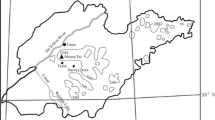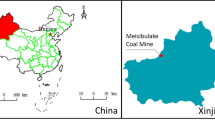Abstract
Mine roof water (water in the overlying aquifers of coal seam) seriously threatens the safe production of coal mines in the Ordos Basin in China. Transient electromagnetic (TEM) and seismic methods are the two key methods of mine roof water detection. To exploit the advantage of each method, the seismic-constrained TEM method is proposed. First, the seismic-constrained TEM inversion algorithm was constructed by adding a cross-gradient function to the pseudo-2D TEM inversion algorithm. The cross-gradient function makes the structures of the TEM and seismic models consistent in inversion. To match the seismic and TEM model grids, the interpolation of the seismic impedance model was proposed. Then, the proposed algorithm was successfully used in the Maiduoshan coal mine in the Ordos Basin. Data acquisition, seismic-constrained TEM inversion and interpretation were carried out. Seventeen boreholes were drilled to verify the interpretation results, and the drilling results are consistent with the detection results. Finally, the seismic-constrained and single TEM methods were compared. Results show that the seismic-constrained TEM method is superior to the single TEM method. The structural consistency of the resistivity and seismic impedance models increases in the seismic-constrained TEM inversion and decreases in the single TEM inversion. Seismic-constrained TEM inversion can add the stratigraphic structure information provided by the seismic method to the TEM inversion, thereby improving the inversion results.









Similar content being viewed by others
References
Bennington, N. L., Zhang, H. J., Thurber, C. H., et al. (2015). Joint inversion of seismic and magnetotelluric data in the Park field region of California using the normalized cross-gradient constraint. Pure and Applied Geophysics, 172(5), 1033–1052.
Chen, K., Xue, G. Q., Chen, W. Y., Zhou, N. N., & Li, H. (2019). Fine and quantitative evaluations of the water volumes in an aquifer above the coal seam roof, based on TEM. Mine Water and the Environment, 38(1), 49–59.
Cheng, J. L., Li, F., Peng, S. P., et al. (2014). Research progress and development direction on advanced detection in mine roadway working face using geophysical methods. Journal of China Coal Society (in Chinese), 39(8), 1742–1750.
Cheng, J. L., Li, F., Peng, S. P., et al. (2015). Joint inversion of TEM and DC in roadway advanced detection based on particle swarm optimization. Journal of Applied Geophysics, 123, 30–35.
Cheng, J. Y., & Shi, X. X. (2013). Current status and development of coal geophysical technology in China. Progress in Geophysics, 28(4), 2024–2032.
Dong, S. N., Ji, Y. D., Wang, H., et al. (2020). Prevention and control technology and application of roof water disaster in Jurassic coal field of Ordos Basin. Journal of China Coal Society, 45(7), 2367–2375.
Fu, X., & Guo, B. L. (2009). Overview of image interpolation technology. Computer Engineering and Design (in Chinese), 30(1), 141–144.
Gallardo, L. A., & Meju, M. A. (2003). Characterization of heterogeneous near-surface materials by joint 2Dinversion of dc resistivity and seismic data. Geophysical Research Letters, 30(13), 1–4.
Gallardo, L. A., Fontes, S. L., Meju, M. A., et al. (2012). Robust geophysical integration through structure-coupled joint inversion and multispectral fusion of seismic reflection, magnetotelluric, magnetic, and gravity images: Example from Santos Basin, offshore Brazil. Geophysics, 77(5), B237–B251.
Guptasarma, D., & Singh, B. (1997). New digital linear filters for Hankel J0 and J1 transforms. Geophysical Prospecting, 45(5), 745–762.
Li, F., Cheng, J. L., Yang, S. T., et al. (2020). Experimental study on joint inversion of water conducted karstic collapse column based on mine TEM and seismic exploration. Journal of China Coal Society, 45(7), 2472–2481.
Moorkamp, M. (2017). Integrating electromagnetic data with other geophysical observations for enhanced imaging of the earth: A tutorial and review. Surveys in Geophysics, 38(5), 935–962.
Moorkamp, M., Roberts, A. W., Jegen, M., et al. (2013). Verification of velocity-resistivity relationships derived from structural joint inversion with borehole data. Geophysical Research Letters, 40(14), 3596–3601.
Ogunbo, J.N., Zhang, J. (2014). Joint seismic travel-time and TEM inversion for near surface imaging. In: SEG: 84th Annual International Meeting, 2104–2108.
Wang, P., Wang, Q., Wang, Y., & Wang, C. (2021). Detection of abandoned coal mine goaf in china’s ordos basin using the transient electromagnetic method. Mine Water and the Environment, 40(2), 415–425.
Wu, Q. (2014). Progress, problem and prospects of prevention and control technology of mine water and reutilization in China. Journal of China Coal Society, 39(5), 795–805.
Xue, G. Q., & Yu, J. C. (2017). New development of TEM research and application in coal mine exploration. Progress in Geophysics, 32(1), 319–326.
Acknowledgements
The research presented in this paper is supported by Natural Science Foundation of China (Grant no. 41974088), Natural Science Foundation of Hebei Province of China (Grant nos. D2019508160, and D2020402032).
Funding
The funding has been received from Natural Science Foundation of China with Grant no. 41974088; Natural Science Foundation of Hebei Province with Grant nos. D2019508160, D2020402032.
Author information
Authors and Affiliations
Contributions
The submission has been received explicitly from all co-authors. And authors whose names appear on the submission have contributed sufficiently to the scientific work.
Corresponding author
Ethics declarations
Conflict of interest
We have no relevant financial or non-financial interests to disclose.
Ethical Statements
We certify that this manuscript is original and has not been published and will not be submitted elsewhere for publication while being considered by Pure and Applied Geophysics. And the study is not split up into several parts to increase the quantity of submissions and submitted to various journals or to one journal over time. No data have been fabricated or manipulated (including images) to support our conclusions. No data, text, or theories by others are presented as if they were our own.
Additional information
Publisher's Note
Springer Nature remains neutral with regard to jurisdictional claims in published maps and institutional affiliations.
Rights and permissions
Springer Nature or its licensor holds exclusive rights to this article under a publishing agreement with the author(s) or other rightsholder(s); author self-archiving of the accepted manuscript version of this article is solely governed by the terms of such publishing agreement and applicable law.
About this article
Cite this article
Li, F., Cheng, J., Wen, L. et al. Mine Roof Water Detection Based On Seismic-Constrained TEM in Ordos Basin, China. Pure Appl. Geophys. 179, 3329–3340 (2022). https://doi.org/10.1007/s00024-022-03125-6
Received:
Revised:
Accepted:
Published:
Issue Date:
DOI: https://doi.org/10.1007/s00024-022-03125-6




